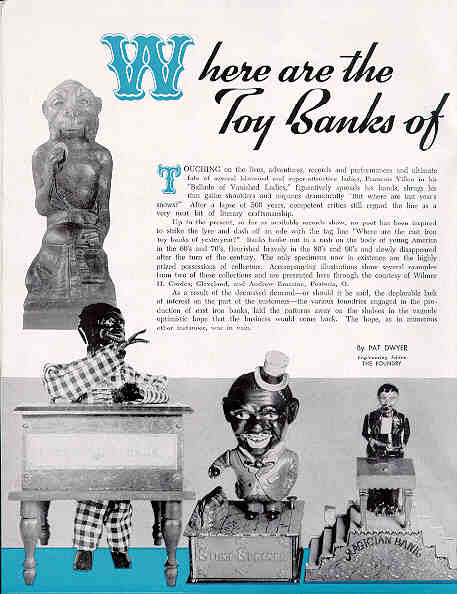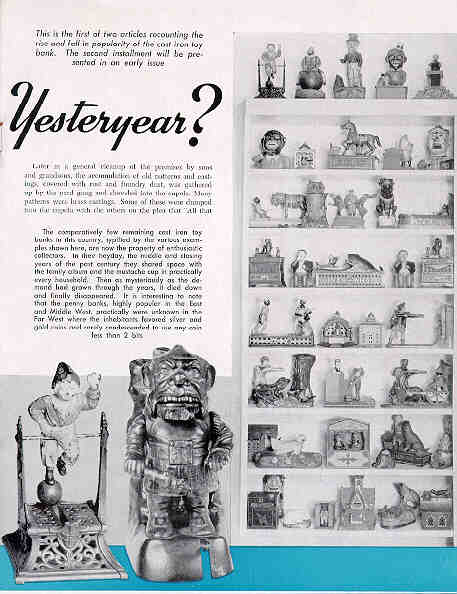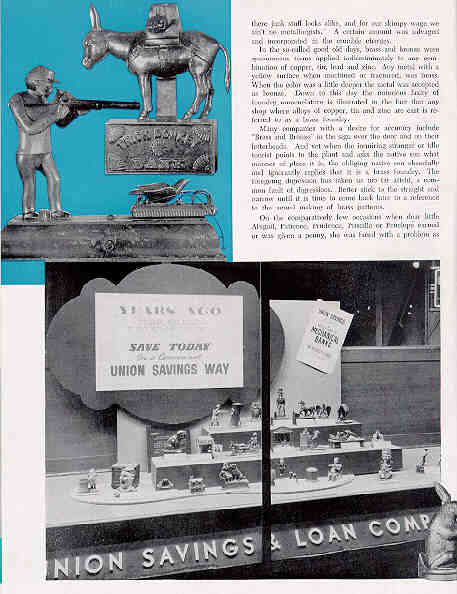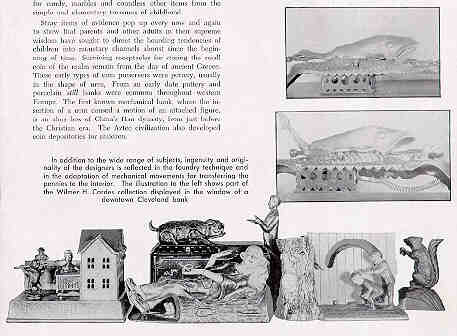By PAT DWYER — Engineering Editor — THE FOUNDRY — April, 1947 — Part 1
Where are the Toy Banks of Yesteryear?

This is the first of two articles recounting the rise
and fall in popularity of the
cast iron toy bank. The second installment will be presented in an eraly issue.
Touching on the lives, adventures, records and performances and ultimate fate of several historical and super-attractive ladies, Francois Villon in his "Ballade of Vanished Ladies," figuratively spreads his hands, shrugs his thin gallic shoulders and inquires dramatically "But where are last year's snows?" After a lapse of 500 years, competent critics still regard the lines as a very neat bit of literary craftsmanship.
Up to the present, so far as available records show, no poet has been inspired to strike the lyre and dash off an ode with the tag line "Where are the cast iron toy banks of yesteryear?" Banks broke out in a rash on the body of young America in the 60’s and 70’s, flourished bravely in the 80’s and 90’s and slowly disappeared after the turn of the century. The only specimens now in existence are the highly prized possessions of collectors. Accompanying illustrations show several examples from two of these collections and are presented here through the courtesy of Wilmer H. Cordes, Cleveland, and Andrew Emerine, Fostoria, O.
As a result of the decreased demand — or should it be said, the deplorable lack of interest on the part of the customers — the various foundries engaged in the production of cast iron banks, laid the patterns away on the shelves in the vaguely optimistic hope that the business would come back. The hope, as in numerous other instances, was in vain.
Later in a general cleanup of the premises by sons and grandsons, the accumulation of old patterns and castings, covered with rust and foundry dust, was gathered up by the yard gang and shoveled into the cupola. Many patterns were brass castings. Some of these were dumped into the cupola with the others on the plea that "all that there junk stuff looks alike, and for our skimpy wage we ain’t no metallurgists." A certain amount was salvaged and incorporated in the crucible charges.

The comparatively few remaining cast iron toy banks in this country, typified by the various examples shown here, are now the property of enthusiastic collectors. In their heyday, the middle and closing years of the past century they shared space with the family album and the mustache cup in practically every household. Then as mysteriously as the demand had grown through the years, it died down and finally disappeared. It is interesting to note that the penny banks, highly popular in the East and Middle West, practically were unknown in the Far West where the inhabitants favored silver and gold coins and rarely condescended to use any coin less than 2 bits.
In the so-called good old days, brass and bronze were synonymous terms applied indiscriminately to any combination of copper, tin, lead and zinc. Any metal with a yellow surface when machined or fractured, was brass. When the color was a little deeper the metal was accepted as bronze. Down to this day the notorious laxity of foundry nomenclature is illustrated in the fact that any shop where alloys of copper, tin and zinc are cast is referred to as a brass foundry.
Many companies with a desire for accuracy include "Brass and Bronze" in the sign over the door and on their letterheads. And yet when the inquiring stranger or idle tourist points to the plant and asks the native son what manner of place it is, the obliging native son cheerfully and ignorantly replies that it is a brass foundry. The foregoing digression has taken us too far afield, a common fault of digressions. Better stick to the straight and narrow until it is time to come back later to a reference to the actual making of brass patterns.
On the comparatively few occasions when dear little Abigail, Patience, Prudence, Priscilla or Penelope earned or was given a penny, she was faced with a problem as serious as that faced by the Priscilla of a former generation. Longfellow’s Priscilla only had to choose between Miles Standish and John Alden. Our little friend had the alternative of kissing her penny goodbye and dropping it into a hold-fast bank, or of taking it fairly in hand and going down the street on a wild spending spree. With cash in hand she was privileged to look at peppermint lozenges, licorice sticks, jaw breakers, wee china dolls, lumps of spruce gum and brilliantly colored pencils. If she was of a thrifty disposition, as small maids of the period sometimes were, either through hereditary influence or extraordinary endowment, or — more likely — through parental coercion, the money would join other small coins in her savings bank. If this piece of household equipment happened to be one of the ingeniously constructed mechanical banks of the period, the little lady probably consoled herself with the reflection that the performance of the animated figure which flipped the penny out of sight, was well worth the price of admission.

From a strictly neutral standpoint it must be admitted that many authorities, self-constituted and otherwise, claim that the desire to collect and preserve is a natural tendency of the human race. They are not surprised to find many helps to young hoarders take the form of toys. Most famous helps of this character are the mechanical banks of 9th century America. These are closely allied to other forms of money boxes, and other toy containers for candy, marbles and countless other items from the simple and elementary treasures of childhood.
Stray items of evidence pop up every now and again to show that parents and other adults in their supreme wisdom have sought to direct the hoarding tendencies of children into monetary channels almost since the beginning of time. Surviving receptacles for storing the small coin of the realm remain from the day of ancient Greece. These early types of coin preservers were pottery, usually in the shape of urns. From an early date pottery and porcelain still banks were common throughout western Europe. The first known mechanical bank, where the insertion of a coin caused a motion of an attached figure, is an alms box of China’s Han dynasty, from just before the Christian era. The Aztec civilization also developed coin depositories for children.
In addition to the wide range of subjects, ingenuity and originality of the designers is reflected in the foundry technique and in the adaptation of mechanical movements for transferring the pennies to the interior. The illustration to the left shows part of the Wilmer H. Cordes collection displayed in the window of a downtown Cleveland bank.
Penny banks made their first appearance in America around 1793 along with the first large copper penny. Their popularity is credited by most authorities to Benjamin Franklin's famous maxims concerning thrift, widely circulated in Poor Richard's Almanac. Another contributory factor, undoubtedly, was the early troubles with U. S. currency and the tendency to favor hard money. Pottery, glass and tin banks were prevalent throughout the early years of the Republic. They were concentrated especially in New England, where thrift was to become a virtue almost rivaling the worship of God. So pronounced did the savin habit become with young and old alike that in cartoon and comment at home and abroad, the typical Yankee was pictured and labeled as a "Pinchpenny."
The social historian would gain much through a study of old letters and documents referring to the subject of thrift. "A penny saved is a penny earned" and "waste not — want not" because the frequent admonitions of youth. The savings bank was a national habit and contributed in no small way to the financial independence of the nation. Nowhere else in the world was the toy bank nearly as popular as in America. A foreign exporting agent of the 1850's commented "The little tin bank always sells there, for it accords well with the grasping character of the race." Already we in America were becoming known for "squeezing the eagle until it screamed." The late 1880's when the American mechanical bank reached the zenith of its glory, also marked the appearance of the phrase "dollar diplomacy."
All through the early 20th century, as American bank balances reached unprecedented heights, thrift and savings were taught assiduously in home and school. It is significant that about the last of the new patents for toy savings banks appeared in 1929, the end of the economic era. Few banks are sold over toy counters today. The weekly bankday collection of children’s savings in the class room has become discredited, due to the one time failure of many banks which once were depositories of school savings. The latest bank that we have seen characteristically makes its appeal to Uncle Sam as the guardian of our hoardings rather than to the private bank. Toy containers, and especially banks, are thus destined to become a distinct memoir of the youth of the 19th century America. A history of toys written from the standpoint of any other country would not have found need for a special chapter on banks.
After 1860 tin banks gradually came to be replaced by banks of cast iron. This material made for sturdier banks, also, owing to its greater tractability could be produced in a greater variety of interesting shapes. Patterns portrayed not only houses, but birds, human beings and animals. Historic objects such as the Liberty Bell and Bunker Hill monument were made in the form of banks. These banks usually were made in two pieces bolted together. It was not necessary to break the bank to get the money out. All that was needed was to unscrew the bolt. As this was not a job for a child, the parent was able to watch over the distribution as well as the acquisition of pennies.

Typify Thrift and Ingenuity
Most of the still cast iron banks now available were made in the late 19th century and the early 20th century, but a few antedate the mechanical variety of cast iron bank. As none of these was patented it is hard to trace their history or place of origin. The safe-type bank, in which money is removed only by working a combination of the door, appeared around 1895 and was popular well into the 1920’s. In the 20th century patents have been taken out for adding sound to still coin receptacles. Few of these have seen the market; nor are banks which light up or ring bells upon deposit of the coin, frequently found.
Mechanical banks of the 19th century represent the union of two fundamental traits of the American Yankee, his thrift and his ingenuity. In the medium of cast iron there appeared a host of action toys which could be operated properly only by insertion of a penny. The purpose which lay behind these elaborate coin receptacles was that children could be lured into the habit of thrift by their curiosity to see the thing work. It is said that this sugar coated method of saving appealed to children. At any rate it did to their parents who bought these mechanical banks in large quantities. Designers vied with each other in the creation of new and startling effects, until in some, the depositing of the coin became but a minor consideration to the feats of movement performed by the cast iron figures of men and animals which overlay the coin receptacle. The subjects of many such banks appealed as much to adults as to children. They became another example of the outpouring of popular fare along with cigar store Indians and Roger's Groups. In this unsophisticated art which appeared in the late 19th century, one can detect that handicraft of real craftsman coupled for the first time with the machinery of mass production.
What is the oldest mechanical bank? Some persons on the questionable authority of personal reminiscence say that the Uncle Sam bank appeared in the 1850's. This was indeed a popular early bank and several companies showed it in their 1870 catalogs. If we are to accept the evidence of patent files, the lever system which is basic to this bank was not developed until the 1870's. The first mechanical bank to be patented (and the great majority were designed so as to be protected by patent) is ordinarily not to be thought of as being in this class. It is a house bank called Hall's Excelsior and it makes no use of the elaborate lever, spring and clockwork arrangements characteristic of the later varieties. The patent (No. 98055) was taken out by John Hall, Watertown, Mass., December, 1869. The patent feature includes a simple balance mechanism located in the roof of the cast iron house, so arranged that when a cupola hatchway is lifted, there is revealed a small figure standing behind a desk. The weight of a penny placed on this desk causes the figure, and penny, to tip forward into the bank. The cupola hatchway then is closed.
Hall made a large number of these banks and they were distributed widely throughout the country. However, we never have seen any in which the man figure (like the patents) was used. Instead there is a tiny monkey, and in some of the later ones the balance hatchway is pulled shut by an attached spring. Perhaps this was added to compensate for the lighter weight of the later one-cent pieces. Hall perfected and made a number of other early mechanical banks, including the bank variously called Fat Man, Boss Tweed or Tammany Bank. His work does not appear in any period after 1880.
J.H. Bowen, Philadelphia, was one of the most ingenious and prolific designers of mechanical banks. To him are credited such well known banks as Creedmore, Kicking Mule, Bulldog, and Monkey and Coconut. Apparently he made his model, and often the casting dies, and then sold these to some manufacturing company, such as the J. & E. Stevens Co., Cromwell, Conn.
Other famous designers were F. Frisbee, who appears always to have been associated with the Stevens company, and C. G. Shepard, Buffalo, who designed and marketed the Jolly Nigger coin swallowing banks and a number of other related types. Not all banks which were patented appear to have been made, and not all banks in existence can be traced to patent sources. May banks used the same mechanical principles; this is illustrated by the variants made from the basic Creedmore design. The original of this bank was produced by the Stevens Co., in 1877. The second variety the Tyrolian (1877), then came the Grenadier 1878), Volunteer (1880), Indian and Bear (1888), William Tell (1896), Teddy and the Bear (1902).
Designed Many Banks
The company most active in mechanical bank production was the J. & E. Stevens Co., of Cromwell, Conn. This iron foundry in 1870 was the first to make moving parts for juggling the penny. Within a few years it was offering no less than 21 distinct patterns to the trade. Its banks are distinguished by patented coin traps. Kingsbury of Keene, N. H.; Hubley of Lancaster, Pa.; Enterprise of Philadelphia; Shepard of Buffalo and Kenton Hardware of Kenton, O. are other famous makers. Old trade catalogs, hard to find, are the surest way of identifying the maker. Few banks are marked by the maker. Many times when they could chance it, several companies copied the bank of a successful competitor. Usually banks were made to retail from $1 to $2 with $4.50 as a top price for a few of the more complicated action toys. such as the Freedman's bank.
Little has been written about the actual construction of mechanical toy banks, but one famous designer, Bowen, has left this record of his creations in a letter to the Philadelphia Times of 1885: "The Creedmore bank was the first I made," said the bank maker. "That was followed by the Kicking Mule the Bulldog and others. I am now at work on a more complicated toy bank. The first bronze casting has just come in. We are now chasing it and filing down all the rough edges, and making all the joints work easily. First of all I make a solid model of the figure in specially prepared ways (wax). From this I take a plaster of paris mold in two parts. Then I make two hollow models of the figure in wax from these molds. The next thing is to separate from the complete models the parts which are intended to be movable.
Patterns Cast in Bronze
"Before me I have the left fore arm and hand of a monkey, holding up a piece of a coconut shell, the thumb of the right hand, the lower jaw, the eyes and the tail which, when the toy is complete, will act in conjunction with a spring on the inside. These parts being removed, I have to make a fresh model in wax of every part, with an end or joint attached to them. They are then sent to the brass foundry to be cast in bronze. The whole figure has to be made complete and working in wax before it goes to the foundry. When they come back some of the pieces are very rough and need a great deal of filing and chasing to make them fit and move easily. The model in bronze that I make is the foundation from which all the banks eventually are to be made and unless my model works perfectly there will be no end of complaints when it goes eventually to the iron foundry, where the marketable toys are turned out."
The foregoing comment was written in the heyday of the mechanical bank, when the production was news. Over 30 patents were issued in the year 1880. Onward from 1885, gradual deterioration took place. The bank became more elaborate, less interesting and not in great demand, The last of the mechanical banks appears to have been advertised around 1908, so that the total span is not much more than 35 years.
The distinctive character of mechanical banks has provided a unique field for the collector, over 300 having been made Each bank can be given a distinctive name and its variants gradually can be tracked down. To one who is not interested in providing a mere check list, several means of classification as to type may be used. one is according to mechanical action, but most banks are lever-and-spring operated, and only a few can be placed in the other class of clock-work operation. Another suggested classification is according to rarity, but as the question of rarity bears no relation to age or action type this would not be especially fruitful. A classification that is fairly common with collectors rest upon the object or central idea of the bank. Upon such a basis one may discern the following types: Negroes, Bank Tellers, Symbolic Figures, Caricatures, Animals, Carnival Themes, and Memorial Banks. Famous caricatures banks include the Tammany or Boss Tweed bank, and the General Butler bank, which portrayed the presidential candidate of the 1884 Greenback Party as a monstrous frog. The animal and carnival theme banks show on the whole the greatest diversity of treatment. Several memorial banks were issued at the time of the 1876 Centennial in Philadelphia. Also for the Columbian and Pan-American expositions which followed.
Another and final method of classification is according to age. 1 - Those of the early 1870's when the mechanical bank was new. 2 - Those of the 1880's when the bank was generally popular. 3 - Those of the 1890's and 4 - Those of the 1900's when the bank had begun its decline in popular favor.
During the 1870's the bank was at its best from a child's standpoint. Simple in design without superfluous ornament, they all make obvious appeal to use the penny. The little Fat Man puts the penny in his pocket. Uncle Sam puts the penny in his valise. The Mother Eagle bends forward and feeds the penny to her young. The Soldier shoots his penny from a cannon into the fort-like safe.
Editor's Note: Historical dates and other interesting data presented here are taken from Cavalcade of Toys through the courtesy of the authors, Ruth and Larry Freeman, and the publisher, Century House, New York.
